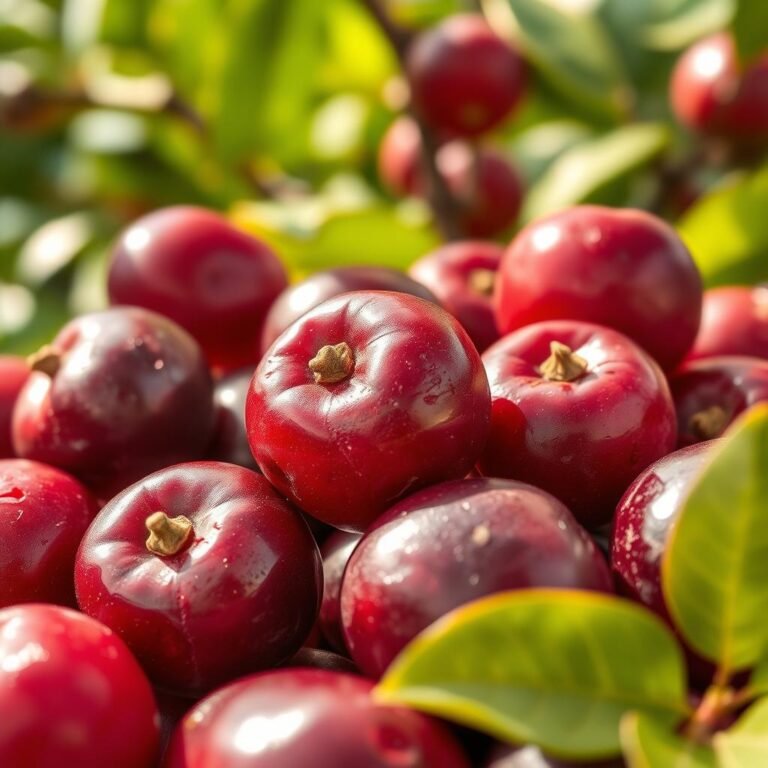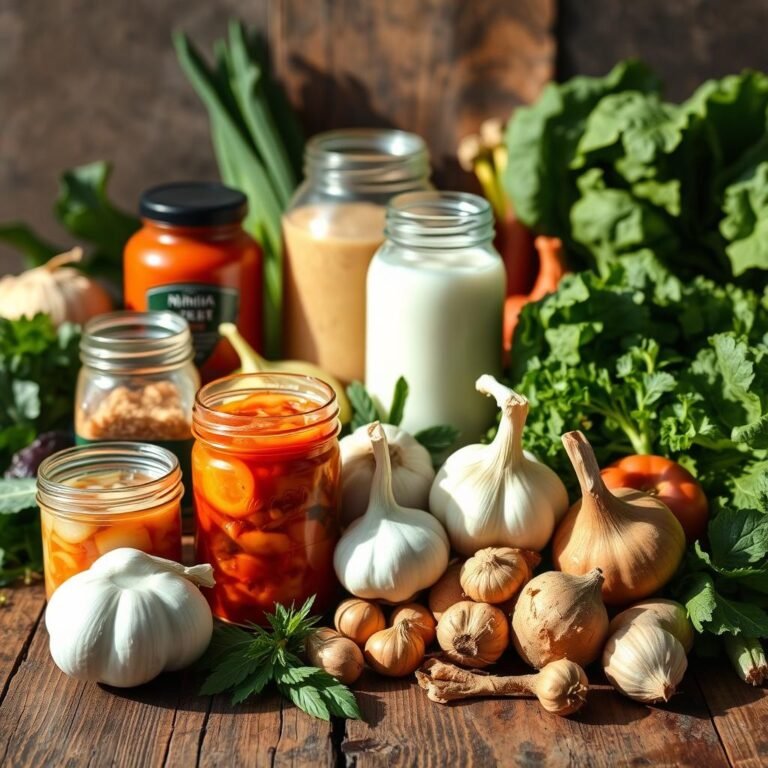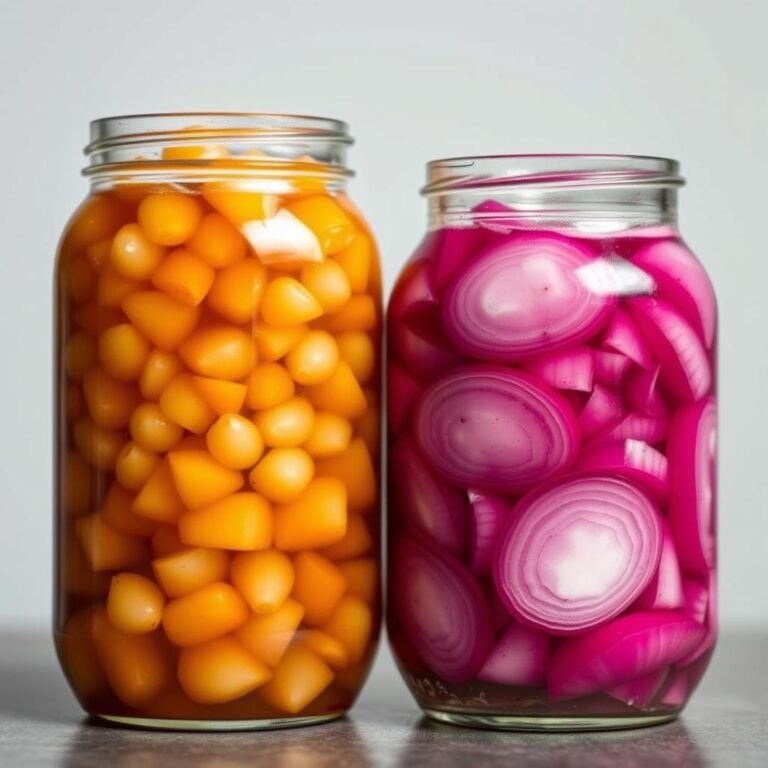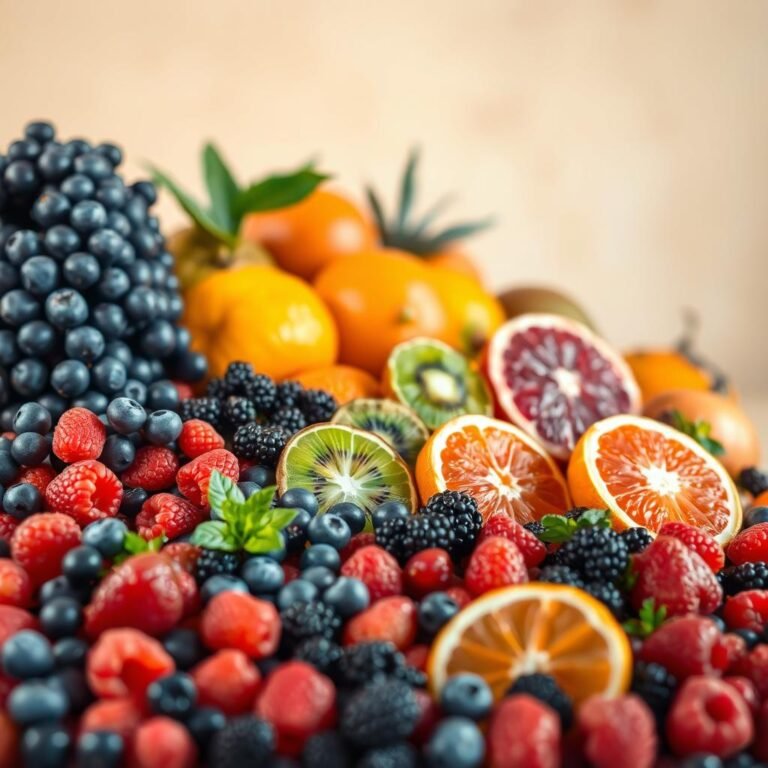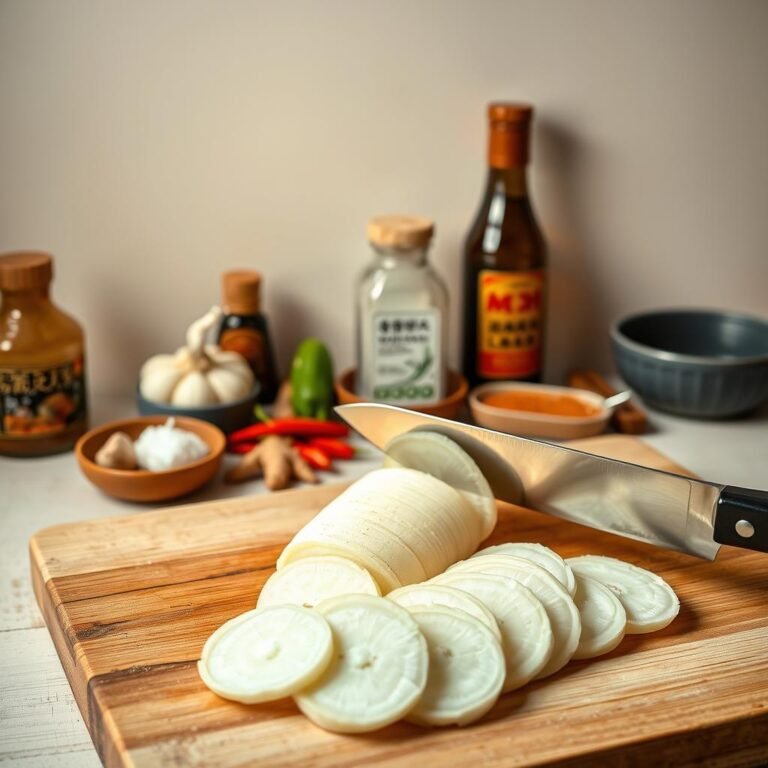Do Pickled Onions Have Probiotics? The Facts
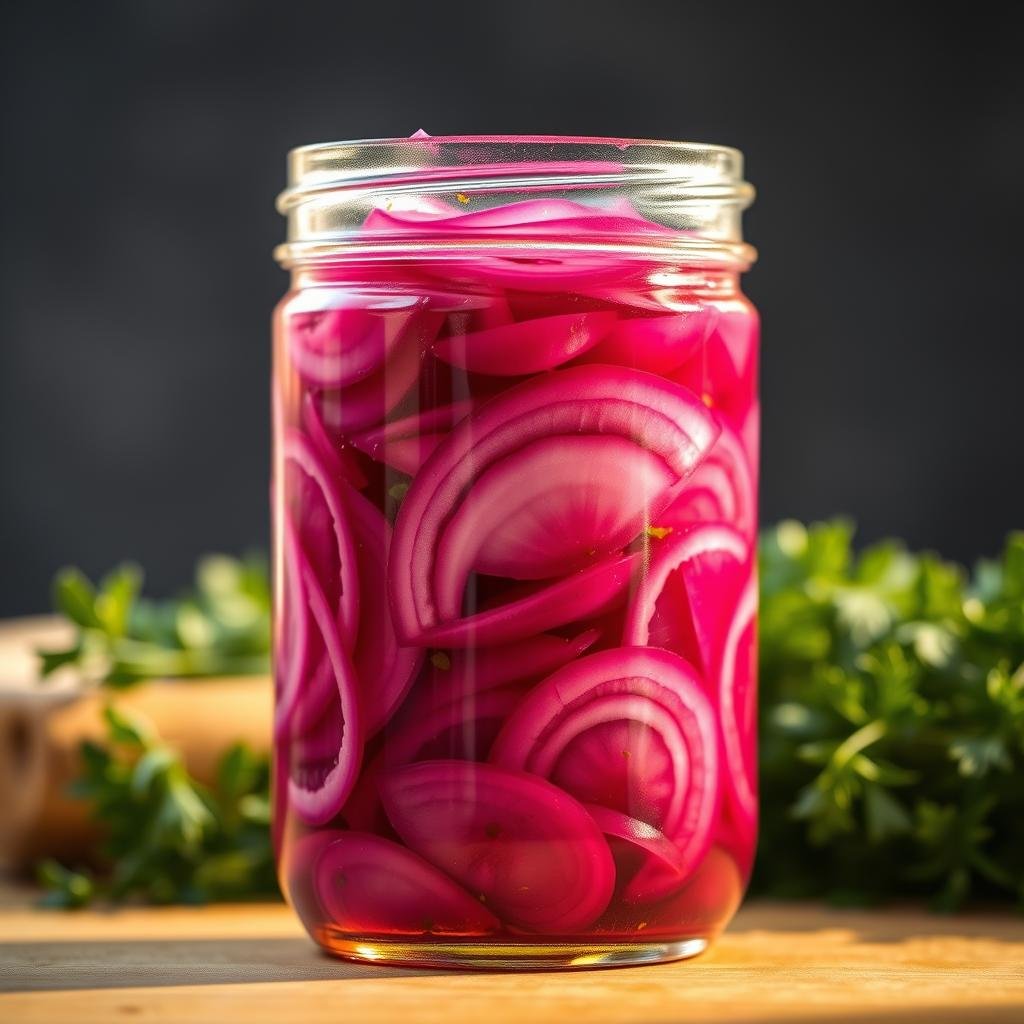
Pickled onions add flavor and health benefits to many dishes. But, do they have probiotics? It’s important to know the difference between pickling and fermentation.
Pickling means soaking foods in vinegar to keep them fresh. This doesn’t help grow good bacteria. Fermentation, on the other hand, uses natural reactions to grow probiotics. Dr. Carlos Jorge says eating fermented foods with probiotics helps the gut, boosts the immune system, and aids in weight control.
Fermented foods have the good bacteria for a healthy gut. To get probiotics from pickled onions, you need fermentation. Find out how to make probiotic-rich pickled onions at home here: detailed guide.
Sources of Probiotics in Pickling
Wondering if do pickled onions have probiotics? The answer lies in traditional fermentation. This method turns vegetables into fermented foods with probiotics. Beneficial bacteria grow by eating the veggies’ sugars and starches.
This creates an acidic environment. It’s perfect for probiotics like lactobacillus to thrive.
The Onion Fermented Pickles are a great example. They’re fermented in a brine with lots of minerals. Each serving has billions of CFUs of lactobacillus.
This traditional method makes them full of probiotics. These are good for your gut. They use local veggies, picked and fermented quickly.
But not all pickled onions are the same. Quick pickling uses vinegar and sugar. It doesn’t support the natural fermentation process.
So, quick pickles don’t have the same probiotic benefits. They might taste tangy, but they’re not as good for your gut as fermented ones.
The Pickling Process Explained
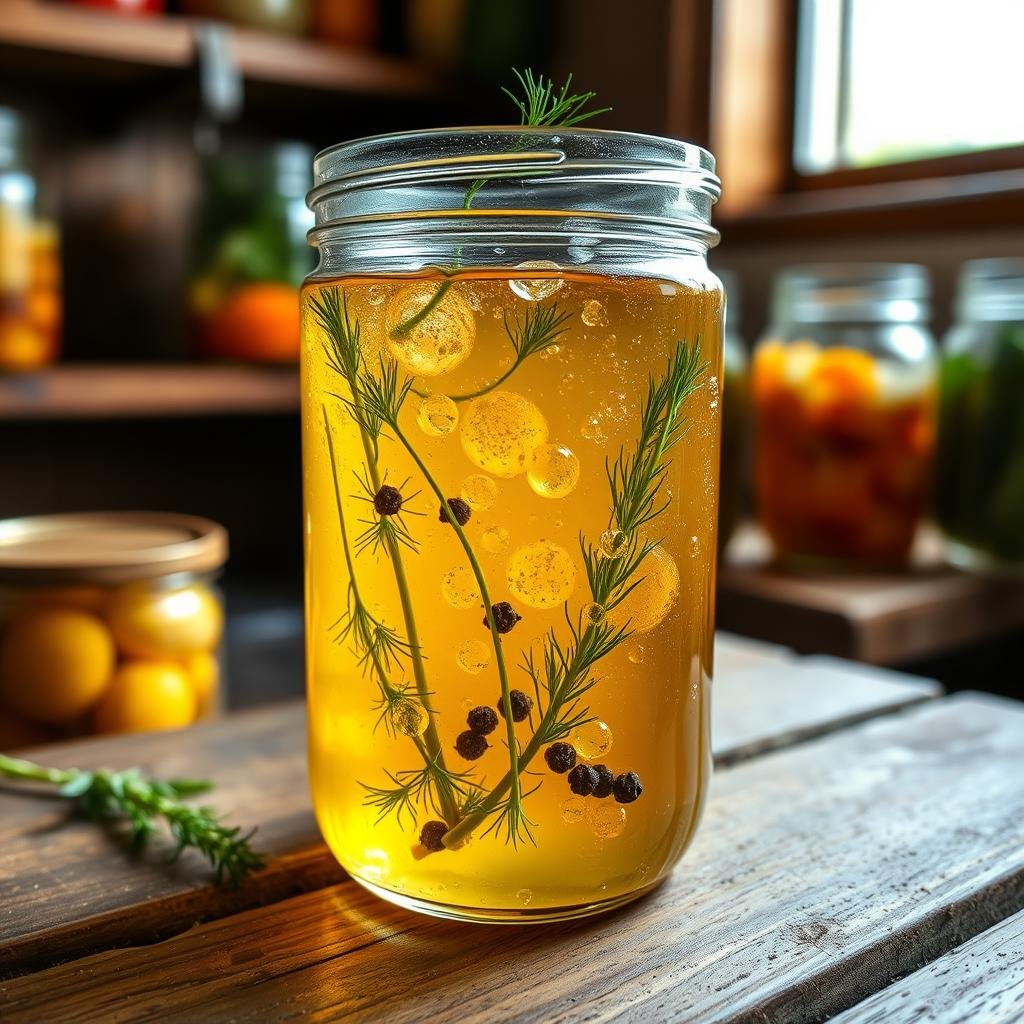
Pickling is a key part of many cuisines. It keeps vegetables fresh and makes them taste better. Knowing how pickling works helps us enjoy the unique flavors and textures.
How Are Pickled Onions Made?
Pickled onions start with thin slices of onions. They soak in vinegar, water, salt, and sometimes sugar. This mix gives them a tangy taste. But, it doesn’t help grow good bacteria like fermentation does.
The Role of Vinegar in Pickling
Vinegar is key in quick pickling. It makes the pickling environment acidic. This stops bad bacteria from growing. Vinegar keeps pickles safe and fresh, but it doesn’t help grow good bacteria.
Fermentation vs. Quick Pickling
Fermentation and quick pickling are different. Fermentation uses good bacteria to make pickles. Quick pickling uses vinegar. Fermentation is better for health because it grows good bacteria.
Do Pickled Onions Contain Living Cultures?
When we talk about pickled onions and health, a big question comes up. Do they have living cultures? The answer depends on how they are pickled.
The Science Behind Pickled Onions
Most pickled onions are made with vinegar. This gives them a tangy taste but doesn’t help living cultures grow. Without fermentation, these onions don’t have the good bacteria found in fermented foods.
Fermentation in Pickled Foods
True fermented foods like sauerkraut and kimchi go through special changes. Natural bacteria turn sugar into lactic acid, showing how fermentation works. This not only keeps the food fresh but also helps probiotics grow.
Can You Ensure Probiotic Content?
To make sure pickled onions have probiotics, use traditional fermentation. Unlike vinegar pickles, lacto-fermented onions keep their live cultures. This is great for your gut health. For a detailed guide on making probiotic-rich pickled onions, check out this comprehensive guide on fermented red onions.
Comparing Fermented and Non-Fermented Pickles
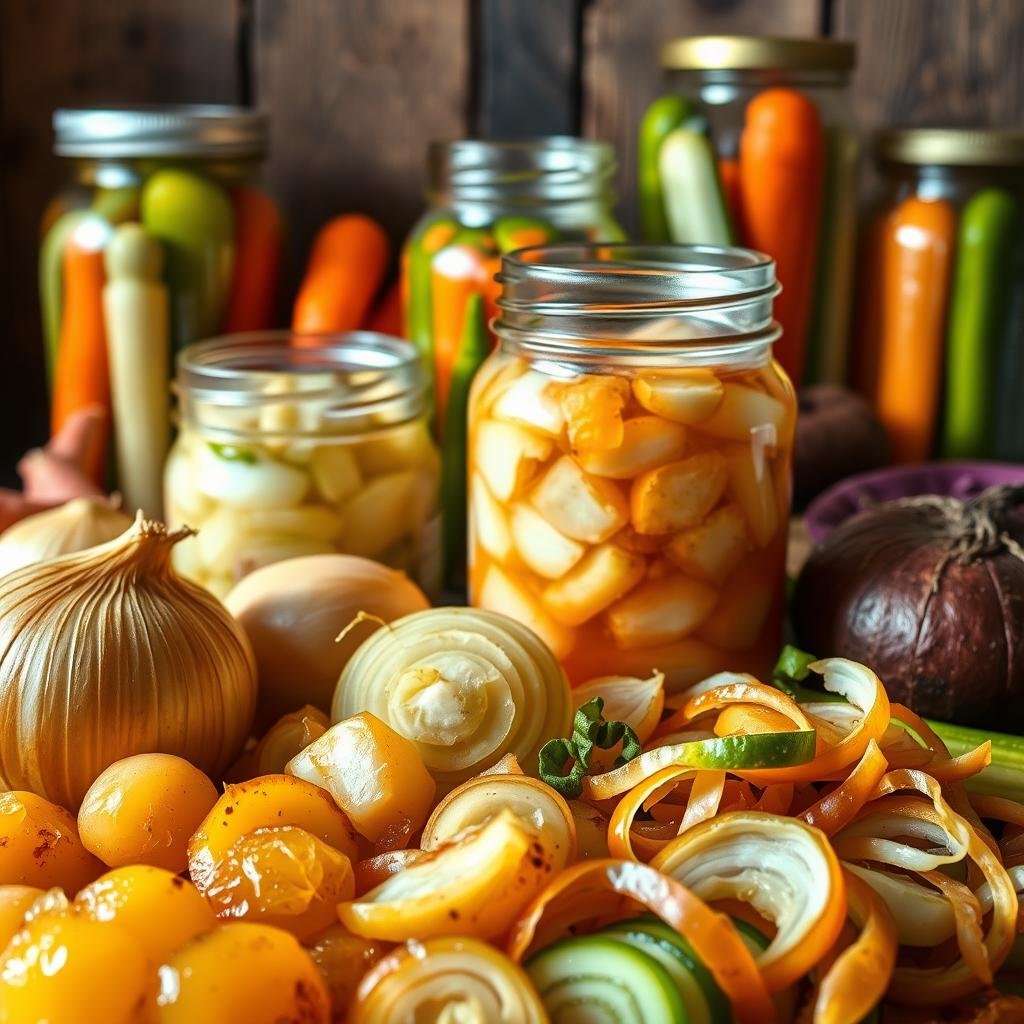
Exploring pickles means knowing the difference between fermented and non-fermented ones. Both can make food taste better, but they’re made differently. They also have different health benefits and tastes.
Differences Between Fermented and Non-Fermented
Fermented pickles use a special process that adds good bacteria. This makes them healthy and tasty. Non-fermented pickles, on the other hand, are made with vinegar. They don’t have the good bacteria.
Nutritional Value of Both Types
The health benefits of pickles depend on if they’re fermented or not. Fermented pickles have live bacteria that’s good for your gut. Non-fermented pickles are just as nutritious as the veggies they’re made from.
| Type | Fermented | Non-Fermented |
|---|---|---|
| Probiotics | Yes | No |
| Preservation Method | Fermentation | Vinegar Solution |
| Health Benefits | Improved Digestive Health | Basic Nutritional Profile |
Flavor Profiles and Usage
The taste of pickles affects how you use them in cooking. Fermented pickles have a deep, sour taste. They’re great for adding flavor to many dishes. Non-fermented pickles are tangy and work well in many recipes too.
Store-Bought vs. Homemade Pickled Onions
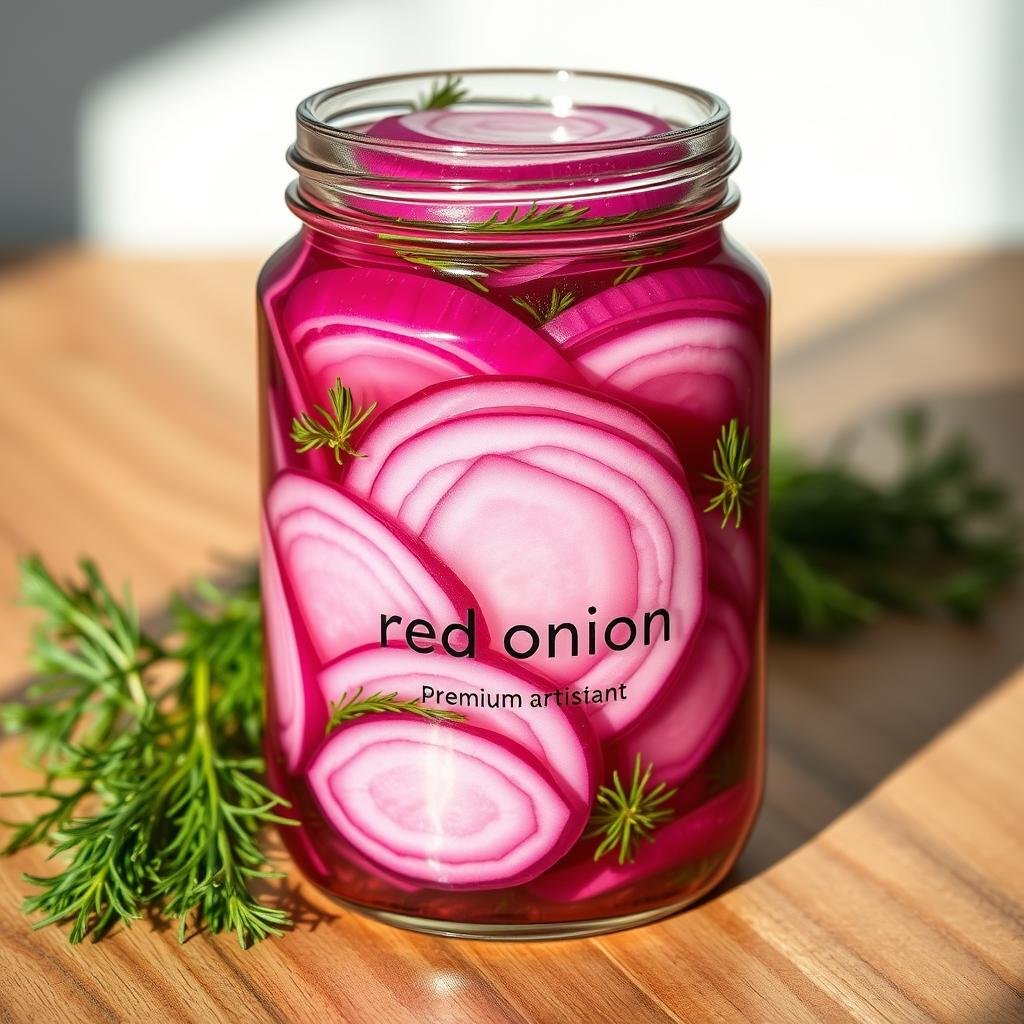
When we talk about the health benefits of store-bought and homemade pickled onions, it’s key to know the differences. Both have their own tastes and textures. But, their health benefits can vary a lot because of the ingredients and how they’re made.
Nutritional Differences in Commercial Products
Store-bought pickled onions often have preservatives and added sugars. These can lower their nutritional value. Making pickled onions at home is better for those who want to avoid these additives and keep the natural probiotics.
Here’s a comparison of the nutritional content of store-bought and homemade pickled onions:
| Store-Bought Pickled Onions | Homemade Pickled Onions | |
|---|---|---|
| Calories | 40 | 30 |
| Sugars | 8g | 3g |
| Preservatives | Commonly present | None |
| Probiotics | Low | High |
Homemade pickled onions don’t have preservatives. This lets you control what goes into them. They can have more probiotics like Lactobacillus zymae and Citrobacter freundii. These are good for your gut. For more on fermented onions, check out this guide.
In short, homemade pickled onions are better for you than store-bought ones. They have more nutrients and probiotics. Choosing homemade means you get a healthier snack that’s good for your gut.
Making Probiotic-Rich Pickled Onions at Home
Making your own probiotic pickles is rewarding and healthy. It’s important to use the right ingredients for fermentation. This way, you get the most out of your probiotic-rich pickled onions.
Ingredients to Include for Probiotics
For probiotic-rich pickled onions, use a brine of natural salt and water. Don’t use vinegar, as it stops fermentation. Adding garlic and dill helps fermentation and makes the taste better.
Best Practices for Consuming Pickled Onions
Pickled onions add flavor and health benefits to your meals. They are great in many dishes. Knowing how to use them can make your food better and healthier, too.
Serving Suggestions
Pickled onions are versatile. They’re good in tacos for a tangy crunch. Or on burgers for extra flavor. They also make salads better with their taste and texture.
How to use pickled onions in a quick meal? Try them in a grain bowl for a zesty kick.
- Tacos: Adds crunch and tang
- Burgers: Enhances the flavor profile
- Salads: Offers texture and zest
- Grain Bowls: Brings a zesty boost
Using fermented pickled onions is even better. They have probiotics that are good for you. Fermented red onions are a tasty way to get probiotics in your diet. You can find guides online to make them at home.
| Dish | How to Use Pickled Onions | Benefits |
|---|---|---|
| Tacos | As a garnish | Enhances flavor and adds crunch |
| Burgers | Layer atop the patty | Provides a tangy contrast |
| Salads | Scatter over greens | Adds zest and crunch |
| Grain Bowls | Mix into bowl | Imparts zesty notes |
Potential Health Risks of Eating Pickled Onions
Pickled onions are tasty but have health concerns. Knowing these risks helps you decide if they’re good for you.
Sodium Content and Its Effects
The sodium in pickles is a big worry. One large dill pickle has over two-thirds of the daily sodium for an adult. This can raise your blood pressure and increase heart attack, stroke, diabetes, and kidney disease risks.
High sodium can also weaken your bones by taking calcium away. This can lead to fractures. For more on sodium risks, check this resource.
Allergies and Sensitivities
Pickled onions allergies, often due to sulfites, are a problem. People with sulfite sensitivities may get hives, stomach pain, or worse. If you think you’re allergic to pickling preservatives, talk to a doctor.
Overconsumption and Digestive Issues
Eating pickled onions in small amounts is okay. But too much can upset your stomach. The vinegar in pickles might cause stomach acid imbalance and discomfort. Enjoy them in moderation to avoid digestive problems.
Signs of Fermentation in Homemade Products
Knowing when your homemade pickles are fermented is key. Look for bubbles in the jar. This means fermentation is happening. Also, a sour but nice smell is a sign of healthy probiotics.
Tips for Determining Quality
Check the texture and taste of your pickles. Fermented red onions should taste tangy and feel smooth. This shows they’ve fermented well. It’s also important to watch out for bad smells or tastes.
Keeping the right conditions during fermentation helps a lot. Follow guides like the FarmSteady guide on fermented red onions. This way, your pickles will taste great and be full of good probiotics.
